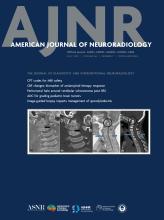Case of the Month
Section Editor: Nicholas Stence, MD
Children's Hospital Colorado, Aurora, CO
June 2013
Next Case of the Month coming July 2...
Orbital Hydatid Cyst
- Background:
- Hydatid disease can occur almost anywhere in the body with a range of imaging appearances, from purely cystic lesions to a completely solid mass.
- Clinical Presentation:
- Unilateral proptosis is the most common clinical presentation.
- Other features include the loss of vision, chemosis, and palpebral edema.
- In endemic areas, painless, slowly progressive proptosis should raise the concern for orbital hydatid.
- Key Diagnostic Features:
-
Imaging features of the orbital hydatid cyst can vary from a cystic to completely solid appearance, with a cystic appearance being the most common and corresponding to WHO CE1 class.
-
On MRI, the cyst is isointense to the vitreous body, appearing hypointense on T1WI and hyperintense on T2WI. Rim enhancement corresponding to the capsule is seen on postcontrast images.
-
Sonographic demonstration of internal echogenic membranes in an orbital hydatid cyst is the equivalent of the water lily sign seen in pulmonary hydatid.
-
- Differential Diagnoses:
- Abscess: Orbital abscess demonstrates orbital fat stranding, central diffusion restriction, and a thick enhancing wall. It is frequently associated with ethmoid or frontal sinusitis.
- Lymphangioma: An ill-defined, unencapsulated, multilocular, infiltrating, cystic mass, involving extraconal and intraconal spaces, often with rimlike enhancement; hyperdensity on CT and mixed signal intensity on T1- and T2-weighted images may be seen due to the presence of blood degradation products of varying ages; the presence of fluid-fluid levels due to repeated hemorrhage is characteristic
- Cysticercosis: Presence of scolex, seen as eccentrically placed hyperdense nodule on the inner aspect of the cyst wall, is diagnostic of cysticercosis; the pericystic inflammation may be seen as thick, irregular, enhancing cyst walls, thickening and edema of involved muscle, and stranding in the orbital fat
- Mucocele: Presents as homogeneous nonenhancing soft-tissue mass with expansion of the involved sinus; remodeling and thinning of the orbital walls leading to protrusion of the mass into the orbit
-
Naso-orbital cephalocele: Presents as orbital soft-tissue mass contiguous to brain parenchyma surrounded by CSF and associated bony defect
-
Colobomatous cysts: They are connected to the globe with a tunnel-like connection and the corresponding eye is well formed but markedly small in size.
- Treatment:
- Surgery is the treatment of choice.
- Pre-op diagnosis is a must to avoid rupture and orbital spread of the disease.











